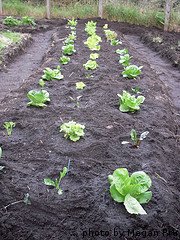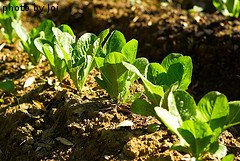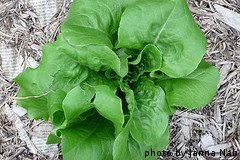Fertilizing and Watering Lettuce
Watering lettuce regularly is very important. It keeps the plants and soil cool and prevents the lettuce from drying out and turning bitter. A dose of fertilizer can be applied after the seedlings emerge to help encourage growth.
Watering Lettuce
During the hot months of summer, lettuce needs an almost constant supply of water. The leaves have an extremely high water content and without enough irrigation, the plants will succumb to the heat and turn bitter.

When watering your lettuce patch, a drip irrigation system is ideal. However, they can be expensive to install. A simple soaker hose will do nicely. You can also use a small pin to poke a single hole in the bottom of a plastic jug. Then fill the jug with water and place it in your lettuce patch. The water will slowly leak out of the jug and into the soil. A gentle sprinkler attached to a garden hose will also do the trick.
The roots of lettuce plants don't go very deep. It's better to water a little bit every couple of days rather than deeply soak your lettuce patch every week. Try to water in the early morning or late afternoon hours. This will prevent the mid-day sun from evaporating the water before it has a chance to penetrate the soil.
Fertilizing Lettuce

Lettuce plants thrive in nutrient-rich soil. Once the seedlings emerge, a dose of fertilizer can be applied to maximize lettuce leaf production. Choose a well-balanced fertilizer with equal parts nitrogen, potassium and phosphate. If using a granular type fertilizer, look for 10-10-10 or 5-5-5 mixtures. Pay close attention to these three number codes. They indicate the amount of nitrogen, phosphate and potassium that are contained in that particular fertilizer,
respectively.
To apply the granular fertilizer in your lettuce patch, scatter the granules on the ground around your plants at about half the rate suggested by the manufacturer. Most fertilizer is applied at a rate of 1 1/2 pounds per 100 square feet, so you should apply it at a rate of 3/4 pound per 100 square feet. Pay attention and try not to let the granules touch the seedlings. After applying the fertilizer, water it in well with a slow soak.
You can also use a well balanced water soluble type fertilizer. Just mix it and apply according to the manufacturer's instructions. If you are watering lettuce plants with a drip jug, just add the water soluble fertilizer to the water in the jug before setting it out in your garden.
Because most lettuce plants mature quickly, a single dose of fertilizer is usually all that is needed to boost production. Wait until the seedlings are a couple of inches tall before applying any fertilizer.
If you want to grow lettuce organically, you can mix compost, well-rotted manure, fish emulsions, etc... into the soil before planting lettuce. This will also give your lettuce plants the nutrients they need to maximize production.

Now that you know all about fertilizing and watering lettuce, it's time to think about harvesting those succulent leaves.
Click here to learn about harvesting lettuce
Click here for some of our favorite lettuce recipes
Click here to move from our Fertilizing and Watering Lettuce page to our Growing Lettuce main page
Click here to go to our Home page